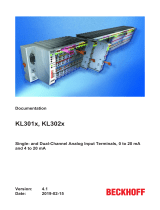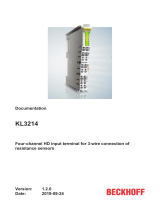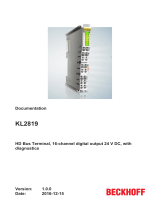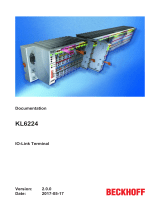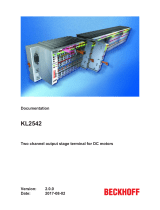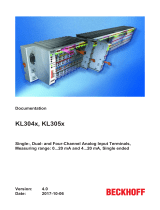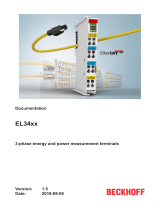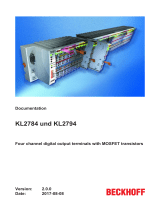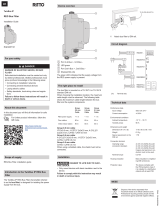Page is loading ...

Documentation
KL3102, KL3112, KL3122
Dual-Channel Analog Input Terminals,-10 V to +10 V, 0/4 mA to
20 mA
3.2
2019-10-15
Version:
Date:


Table of contents
KL3102, KL3112, KL3122 3Version: 3.2
Table of contents
1 Foreword ....................................................................................................................................................5
1.1 Notes on the documentation..............................................................................................................5
1.2 Safety instructions .............................................................................................................................6
1.3 Documentation issue status ..............................................................................................................7
1.4 Beckhoff Identification Code (BIC) ....................................................................................................7
2 Product Overview ....................................................................................................................................10
2.1 Overview of two-channel analog input terminals .............................................................................10
2.2 KL3102 - Introduction ......................................................................................................................10
2.3 KL3102 - Technical data..................................................................................................................11
2.4 KL3112, KL3122 - Introduction........................................................................................................12
2.5 KL3112, KL3122 - Technical data ...................................................................................................13
2.6 Basic function principles ..................................................................................................................14
3 Mounting and wiring................................................................................................................................16
3.1 Instructions for ESD protection........................................................................................................16
3.2 Installation on mounting rails ...........................................................................................................16
3.3 Installation instructions for enhanced mechanical load capacity .....................................................20
3.4 Connection ......................................................................................................................................20
3.4.1 Connection system .......................................................................................................... 20
3.4.2 Wiring............................................................................................................................... 23
3.4.3 Shielding .......................................................................................................................... 24
3.5 KL3102 - Connection and LED description .....................................................................................25
3.6 KL3112, KL3122 - Connection and LED description .......................................................................26
3.7 ATEX - Special conditions (standard temperature range) ...............................................................27
3.8 ATEX Documentation ......................................................................................................................28
4 Configuration Software KS2000.............................................................................................................29
4.1 KS2000 - Introduction......................................................................................................................29
4.2 Sample program for KL register communication via EtherCAT on KL3314 exemplary...................30
5 Access from the user program ..............................................................................................................33
5.1 Terminal configuration .....................................................................................................................33
5.2 Mapping in the Bus Coupler ............................................................................................................34
5.2.1 KL3102, KL3112, KL3122................................................................................................ 35
5.3 Register overview ............................................................................................................................35
5.4 Register description.........................................................................................................................36
5.5 Control and status byte....................................................................................................................41
5.5.1 Process data exchange ................................................................................................... 41
5.5.2 Register communication .................................................................................................. 42
5.6 Examples of Register Communication ............................................................................................43
5.6.1 Example 1: reading the firmware version from Register 9............................................... 43
5.6.2 Example 2: Writing to an user register............................................................................. 44
6 Appendix ..................................................................................................................................................47
6.1 Support and Service ........................................................................................................................47

Table of contents
KL3102, KL3112, KL31224 Version: 3.2

Foreword
KL3102, KL3112, KL3122 5Version: 3.2
1 Foreword
1.1 Notes on the documentation
Intended audience
This description is only intended for the use of trained specialists in control and automation engineering who
are familiar with the applicable national standards.
It is essential that the documentation and the following notes and explanations are followed when installing
and commissioning these components.
It is the duty of the technical personnel to use the documentation published at the respective time of each
installation and commissioning.
The responsible staff must ensure that the application or use of the products described satisfy all the
requirements for safety, including all the relevant laws, regulations, guidelines and standards.
Disclaimer
The documentation has been prepared with care. The products described are, however, constantly under
development.
We reserve the right to revise and change the documentation at any time and without prior announcement.
No claims for the modification of products that have already been supplied may be made on the basis of the
data, diagrams and descriptions in this documentation.
Trademarks
Beckhoff
®
, TwinCAT
®
, EtherCAT
®
, EtherCATG
®
, EtherCATG10
®
, EtherCATP
®
, SafetyoverEtherCAT
®
,
TwinSAFE
®
, XFC
®
, XTS
®
and XPlanar
®
are registered trademarks of and licensed by Beckhoff Automation
GmbH. Other designations used in this publication may be trademarks whose use by third parties for their
own purposes could violate the rights of the owners.
Patent Pending
The EtherCAT Technology is covered, including but not limited to the following patent applications and
patents: EP1590927, EP1789857, EP1456722, EP2137893, DE102015105702 with corresponding
applications or registrations in various other countries.
EtherCAT
®
is registered trademark and patented technology, licensed by Beckhoff Automation GmbH,
Germany.
Copyright
© Beckhoff Automation GmbH & Co. KG, Germany.
The reproduction, distribution and utilization of this document as well as the communication of its contents to
others without express authorization are prohibited.
Offenders will be held liable for the payment of damages. All rights reserved in the event of the grant of a
patent, utility model or design.

Foreword
KL3102, KL3112, KL31226 Version: 3.2
1.2 Safety instructions
Safety regulations
Please note the following safety instructions and explanations!
Product-specific safety instructions can be found on following pages or in the areas mounting, wiring,
commissioning etc.
Exclusion of liability
All the components are supplied in particular hardware and software configurations appropriate for the
application. Modifications to hardware or software configurations other than those described in the
documentation are not permitted, and nullify the liability of Beckhoff Automation GmbH & Co. KG.
Personnel qualification
This description is only intended for trained specialists in control, automation and drive engineering who are
familiar with the applicable national standards.
Description of instructions
In this documentation the following instructions are used.
These instructions must be read carefully and followed without fail!
DANGER
Serious risk of injury!
Failure to follow this safety instruction directly endangers the life and health of persons.
WARNING
Risk of injury!
Failure to follow this safety instruction endangers the life and health of persons.
CAUTION
Personal injuries!
Failure to follow this safety instruction can lead to injuries to persons.
NOTE
Damage to environment/equipment or data loss
Failure to follow this instruction can lead to environmental damage, equipment damage or data loss.
Tip or pointer
This symbol indicates information that contributes to better understanding.

Foreword
KL3102, KL3112, KL3122 7Version: 3.2
1.3 Documentation issue status
Version Comment
3.2 • Update chapter “Instructions for ESD protection”
• Chapter “Beckhoff Identification Code (BIC)” added
3.1 • Example program added to chapter “KS2000 Configuration software“
• Design of the safety instructions adapted to IEC 82079-1
3.0 • Migration
• Update Technical data
• Structure update
• Chapter Mounting and wiring added
• Chapters KS2000 configuration software and Access from the user program added
Firmware and hardware versions
Documen-
tation,
Version
KL3102 KL3112 KL3122
Firmware Hardware Firmware Hardware Firmware Hardware
3.1 3B 09 3B 05 3B 05
3.0 3B 09 3B 05 3B 05
The firmware and hardware versions (delivery state) of the terminal can be found in the serial number printed
on the side.
Syntax of the serial number
Structure of the serial number: WWYYFFHH
WW - week of production (calendar week)
YY - year of production
FF - firmware version
HH - hardware version
Example with ser. no.: 35 04 1B 01:
35 - week of production 35
4 - year of production 2004
1B - firmware version 1B
1 - hardware version 1
1.4 Beckhoff Identification Code (BIC)
The Beckhoff Identification Code (BIC) is increasingly being applied to Beckhoff products to uniquely identify
the product. The BIC is represented as a Data Matrix Code (DMC, code scheme ECC200), the content is
based on the ANSI standard MH10.8.2-2016.

Foreword
KL3102, KL3112, KL31228 Version: 3.2
Fig.1: BIC as data matrix code (DMC, code scheme ECC200)
The BIC will be introduced step by step across all product groups.
Depending on the product, it can be found in the following places:
• on the packaging unit
• directly on the product (if space suffices)
• on the packaging unit and the product
The BIC is machine-readable and contains information that can also be used by the customer for handling
and product management.
Each piece of information can be uniquely identified using the so-called data identifier
(ANSIMH10.8.2-2016). The data identifier is followed by a character string. Both together have a maximum
length according to the table below. If the information is shorter, spaces are added to it. The data under
positions 1 to 4 are always available.
The following information is contained:
Item
no.
Type of
information
Explanation Data
identifier
Number of digits
incl. data identifier
Example
1 Beckhoff order
number
Beckhoff order number 1P 8 1P072222
2 Beckhoff Traceability
Number (BTN)
Unique serial number,
see note below
S 12 SBTNk4p562d7
3 Article description Beckhoff article
description, e.g.
EL1008
1K 32 1KEL1809
4 Quantity Quantity in packaging
unit, e.g. 1, 10, etc.
Q 6 Q1
5 Batch number Optional: Year and week
of production
2P 14 2P401503180016
6 ID/serial number Optional: Present-day
serial number system,
e.g. with safety products
51S 12 51S678294104
7 Variant number Optional: Product variant
number on the basis of
standard products
30P 32 30PF971, 2*K183
...

Foreword
KL3102, KL3112, KL3122 9Version: 3.2
Further types of information and data identifiers are used by Beckhoff and serve internal processes.
Structure of the BIC
Example of composite information from item 1 to 4 and 6. The data identifiers are marked in red for better
display:
BTN
An important component of the BIC is the Beckhoff Traceability Number (BTN, item no.2). The BTN is a
unique serial number consisting of eight characters that will replace all other serial number systems at
Beckhoff in the long term (e.g. batch designations on IO components, previous serial number range for
safety products, etc.). The BTN will also be introduced step by step, so it may happen that the BTN is not yet
coded in the BIC.
NOTE
This information has been carefully prepared. However, the procedure described is constantly being further
developed. We reserve the right to revise and change procedures and documentation at any time and with-
out prior notice. No claims for changes can be made from the information, illustrations and descriptions in
this information.

Product Overview
KL3102, KL3112, KL312210 Version: 3.2
2 Product Overview
2.1 Overview of two-channel analog input terminals
Module Signal voltage Signal current Filter
KL3102 [}10]
-10V ... +10V 50Hz, configurable
KL3112 [}12]
0mA ... 20mA 50Hz, configurable
KL3122 [}12]
4mA ... 20mA 50Hz, configurable
2.2 KL3102 - Introduction
Fig.2: KL3102
Two-channel analog input terminal -10V…+10V
The analog input terminal KL3102 processes signals in the range of -10V to +10V. The voltage is digitized
to a resolution of 16bits, and is transmitted, electrically isolated, to the higher-level automation device. The
input channels of one Bus Terminal have differential inputs and possess a common, internal ground
potential. The KL3102 combines two channels in a single housing. The two LEDs give an indication of the
data exchange with the Bus Coupler.

Product Overview
KL3102, KL3112, KL3122 11Version: 3.2
2.3 KL3102 - Technical data
Technical data KL3102
Number of inputs 2
Power supply for the electronics via the K-bus
Signal voltage -10V … +10V
Technology Differential input
Internal resistance >200kΩ
Common-mode voltage U
CM
max. 35V
Resolution 16bit (for the 0V to 10V range from: resolution 15bit)
Conversion time 140ms, configurable to 2ms
Filter 50Hz, configurable
Measuring error (total measuring
range)
<±0.3% relative to full scale value
Electrical isolation 500V (K-bus / signal voltage)
Current consumption K-bus typically 65mA
Bit width in the K-bus I/O Input: 2 x 16bits of data (2 x 8bits control/status optional)
Configuration No address or configuration settings
Weight approx. 70g
Dimensions (WxHxD) approx. 15mmx100mmx70mm (width aligned: 12mm)
Mounting [}16]
on 35mm mounting rail according to EN60715
Permissible ambient temperature
range during operation
0°C ... + 55°C
Permissible ambient temperature
range during storage
-25°C ... + 85°C
Permissible relative air humidity 95%, no condensation
Vibration / shock resistance
conforms to EN60068-2-6/ EN60068-2-27, see also Installation
instructions for enhanced mechanical load capacity [}20]
EMC immunity/emission conforms to EN61000-6-2 / EN61000-6-4
Protection class IP20
Installation position variable
Approval
CE, cULus, ATEX [}27]

Product Overview
KL3102, KL3112, KL312212 Version: 3.2
2.4 KL3112, KL3122 - Introduction
Fig.3: KL3112, KL3122
Two-channel analog input terminals 0mA...20mA and 4mA...20mA
The analog input terminals process signals in the range of
• KL3112: 0mA ... 20mA
• KL3122: 4mA ... 20mA.
The current is digitized to a resolution of 16bits (default: 15bits), and is transmitted, in an electrically
isolated form, to the higher-level automation device. The input channels of the Bus Terminals have
differential inputs and possess a common, internal ground potential. The terminals combine two channels in
a single housing. A wire breakage or overload condition are detected, and the terminal state is relayed to the
controller via the K-bus. The Run LEDs indicate the data exchange with the Bus Coupler, while the Error
LEDs indicate overload.

Product Overview
KL3102, KL3112, KL3122 13Version: 3.2
2.5 KL3112, KL3122 - Technical data
Technical data KL3112 KL3122
Number of inputs 2
Power supply for the electronics via the K-bus
Signal voltage 0mA…20mA 4mA…20mA
Technology Differential input
Internal resistance 50Ω measuring resistance, load: 60Ω + diode voltage
Common-mode voltage U
CM
max. 35V
Resolution 15bits (configurable to 16bits)
Conversion time 140ms, configurable to 2ms
Filter 50Hz, configurable
Measuring error (total measuring
range)
<±0.3% of the full scale value
Surge voltage resistance 35V
DC
Electrical isolation 500V (K-bus / signal voltage)
Current consumption K-bus typically 60mA
Bit width in the K-bus I/O Input: 2 x 16bits of data (2 x 8bits control/status optional)
Configuration No address or configuration settings
Weight approx. 70g
Dimensions (WxHxD) approx. 15mmx100mmx70mm (width aligned: 12mm)
Mounting [}16]
on 35mm mounting rail according to EN60715
Permissible ambient temperature
range during operation
0°C ... + 55°C
Permissible ambient temperature
range during storage
-25°C ... + 85°C
Permissible relative air humidity 95%, no condensation
Vibration / shock resistance
conforms to EN60068-2-6/ EN60068-2-27, see also Installation
instructions for enhanced mechanical load capacity [}20]
EMC immunity/emission conforms to EN61000-6-2 / EN61000-6-4
Protection class IP20
Installation position variable
Approval
CE, cULus, ATEX [}27]

Product Overview
KL3102, KL3112, KL312214 Version: 3.2
2.6 Basic function principles
The analog input terminals process signals in the range of:
KL3102: -10V ... +10V
KL3112: 0mA ... 20mA
KL3122: 4mA ... 20mA
with a resolution of up to 16bits (65535 steps). The terminal inputs are differential inputs with common
ground. Due to the differential inputs, the terminals are particularly suitable for floating measuring of voltage
drops. In the standard version, a filter with a stop frequency (64.5dB) of 50Hz is active. The filter constant
and the associated conversion time are configurable in a wide range.
The green Run LEDs indicate the operating state of the associated terminal channel.
• On: Normal operation
• Off: Watchdog-timer overflow has occurred. If no process data are transmitted by the Bus Coupler for
100ms, the green LEDs go out.
The red ERROR LEDs indicate an overflow.
• On: Measured current outside the measuring range (> 20mA)
• Off: Current in valid range
KL3102 - Output format of the process data
In the delivery state the process data are shown in two's complement form (integer -1 corresponds to
0xFFFF). Other presentation types can be selected via the feature register (R32) [}38] (e.g.signed amount
representation, Siemens output format).
Measured value Output
KL3102 dec hex
-10V -32768 0x8000
-5V -16383 0xC001
0V 0 0x0000
5V 16383 0x3FFF
10V 32767 0x7FFF
KL3112, KL3122 - Output format of the process data
In the delivery state the process data are shown in two's complement form (integer -1 corresponds to
0xFFFF). Other presentation types can be selected via the feature register (R32 [}38]) (e.g.signed amount
representation, Siemens output format).
Measured value Output
KL3112 KL3122 dec hex
0mA 4mA 0 0x0000
10mA 12mA 16383 0x3FFF
20mA 20mA 32767 0x7FFF
Calculation of process data
The terminal continuously records measured values and stores the raw values of its A/D converter in register
R0 [}36] (RAM ). The calculation of the correction with the calibration values takes place after each
sampling of the analog signal. This is followed by manufacturer and user scaling:
The process data that are transferred to the Bus Coupler are calculated using the following equations:

Product Overview
KL3102, KL3112, KL3122 15Version: 3.2
Y_a = (B_a + X_adc) * A_a
Y_aus = Y_a
(1.0) Neither user nor manufacturer scaling is active.
Y_1 = B_h + A_h * Y_a
Y_aus = Y_1
(1.1) Manufacturer scaling active: (Default setting)
Y_2 = B_w + A_w * Y_a
Y_aus = Y_2
(1.2) User scaling active
Y_1 = B_h + A_h * Y_a
Y_2 = B_w + A_w * Y_1
Y_aus = Y_2
(1.3)
(1.4)
Manufacturer and user scaling active
Key
Name Designation Register
X_adc Output value of the A/D converter -
Y_aus Process data for controller -
B_a Vendor calibration: Offset
R17 [}37]
A_a Vendor calibration: Gain
R18 [}38]
B_h Manufacturer scaling: Offset
R19 [}38]
A_h Manufacturer scaling: Gain
R20 [}38]
B_w User scaling: Offset
R33 [}38]
A_w User scaling: Gain
R34 [}39]
The equations of the straight line are enabled via register R32 [}38]
Fig.4: KL3102, KL3112, KL3122 - Data flow

Mounting and wiring
KL3102, KL3112, KL312216 Version: 3.2
3 Mounting and wiring
3.1 Instructions for ESD protection
NOTE
Destruction of the devices by electrostatic discharge possible!
The devices contain components at risk from electrostatic discharge caused by improper handling.
• Please ensure you are electrostatically discharged and avoid touching the contacts of the device directly.
• Avoid contact with highly insulating materials (synthetic fibers, plastic film etc.).
• Surroundings (working place, packaging and personnel) should by grounded probably, when handling
with the devices.
• Each assembly must be terminated at the right hand end with a KL9010 bus end terminal, to ensure the
protection class and ESD protection.
Fig.5: Spring contacts of the Beckhoff I/O components
3.2 Installation on mounting rails
WARNING
Risk of electric shock and damage of device!
Bring the bus terminal system into a safe, powered down state before starting installation, disassembly or
wiring of the bus terminals!

Mounting and wiring
KL3102, KL3112, KL3122 17Version: 3.2
Assembly
Fig.6: Attaching on mounting rail
The bus coupler and bus terminals are attached to commercially available 35mm mounting rails (DIN rails
according to EN60715) by applying slight pressure:
1. First attach the fieldbus coupler to the mounting rail.
2. The bus terminals are now attached on the right-hand side of the fieldbus coupler. Join the compo-
nents with tongue and groove and push the terminals against the mounting rail, until the lock clicks
onto the mounting rail.
If the terminals are clipped onto the mounting rail first and then pushed together without tongue and
groove, the connection will not be operational! When correctly assembled, no significant gap should
be visible between the housings.
Fixing of mounting rails
The locking mechanism of the terminals and couplers extends to the profile of the mounting rail. At
the installation, the locking mechanism of the components must not come into conflict with the fixing
bolts of the mounting rail. To mount the mounting rails with a height of 7.5mm under the terminals
and couplers, you should use flat mounting connections (e.g. countersunk screws or blind rivets).

Mounting and wiring
KL3102, KL3112, KL312218 Version: 3.2
Disassembly
Fig.7: Disassembling of terminal
Each terminal is secured by a lock on the mounting rail, which must be released for disassembly:
1. Pull the terminal by its orange-colored lugs approximately 1cm away from the mounting rail. In doing
so for this terminal the mounting rail lock is released automatically and you can pull the terminal out of
the bus terminal block easily without excessive force.
2. Grasp the released terminal with thumb and index finger simultaneous at the upper and lower grooved
housing surfaces and pull the terminal out of the bus terminal block.
Connections within a bus terminal block
The electric connections between the Bus Coupler and the Bus Terminals are automatically realized by
joining the components:
• The six spring contacts of the K-Bus/E-Bus deal with the transfer of the data and the supply of the Bus
Terminal electronics.
• The power contacts deal with the supply for the field electronics and thus represent a supply rail within
the bus terminal block. The power contacts are supplied via terminals on the Bus Coupler (up to 24V)
or for higher voltages via power feed terminals.
Power Contacts
During the design of a bus terminal block, the pin assignment of the individual Bus Terminals must
be taken account of, since some types (e.g. analog Bus Terminals or digital 4-channel Bus Termi-
nals) do not or not fully loop through the power contacts. Power Feed Terminals (KL91xx, KL92xx
or EL91xx, EL92xx) interrupt the power contacts and thus represent the start of a new supply rail.
PE power contact
The power contact labeled PE can be used as a protective earth. For safety reasons this contact mates first
when plugging together, and can ground short-circuit currents of up to 125A.

Mounting and wiring
KL3102, KL3112, KL3122 19Version: 3.2
Fig.8: Power contact on left side
NOTE
Possible damage of the device
Note that, for reasons of electromagnetic compatibility, the PE contacts are capacitatively coupled to the
mounting rail. This may lead to incorrect results during insulation testing or to damage on the terminal (e.g.
disruptive discharge to the PE line during insulation testing of a consumer with a nominal voltage of 230V).
For insulation testing, disconnect the PE supply line at the Bus Coupler or the Power Feed Terminal! In or-
der to decouple further feed points for testing, these Power Feed Terminals can be released and pulled at
least 10mm from the group of terminals.
WARNING
Risk of electric shock!
The PE power contact must not be used for other potentials!

Mounting and wiring
KL3102, KL3112, KL312220 Version: 3.2
3.3 Installation instructions for enhanced mechanical load
capacity
WARNING
Risk of injury through electric shock and damage to the device!
Bring the Bus Terminal system into a safe, de-energized state before starting mounting, disassembly or
wiring of the Bus Terminals!
Additional checks
The terminals have undergone the following additional tests:
Verification Explanation
Vibration 10 frequency runs in 3 axes
6 Hz < f < 60 Hz displacement 0.35 mm, constant amplitude
60.1Hz<f<500Hz acceleration 5g, constant amplitude
Shocks 1000 shocks in each direction, in 3 axes
25 g, 6 ms
Additional installation instructions
For terminals with enhanced mechanical load capacity, the following additional installation instructions apply:
• The enhanced mechanical load capacity is valid for all permissible installation positions
• Use a mounting rail according to EN 60715 TH35-15
• Fix the terminal segment on both sides of the mounting rail with a mechanical fixture, e.g. an earth
terminal or reinforced end clamp
• The maximum total extension of the terminal segment (without coupler) is:
64 terminals (12 mm mounting with) or 32 terminals (24 mm mounting with)
• Avoid deformation, twisting, crushing and bending of the mounting rail during edging and installation of
the rail
• The mounting points of the mounting rail must be set at 5 cm intervals
• Use countersunk head screws to fasten the mounting rail
• The free length between the strain relief and the wire connection should be kept as short as possible. A
distance of approx. 10 cm should be maintained to the cable duct.
3.4 Connection
3.4.1 Connection system
WARNING
Risk of electric shock and damage of device!
Bring the bus terminal system into a safe, powered down state before starting installation, disassembly or
wiring of the bus terminals!
Overview
The Bus Terminal system offers different connection options for optimum adaptation to the respective
application:
• The terminals of ELxxxx and KLxxxx series with standard wiring include electronics and connection
level in a single enclosure.
/
